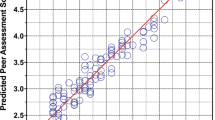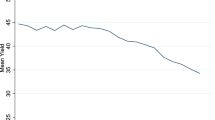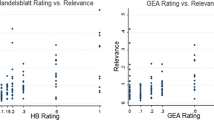Abstract
Using a conceptual model, this study examines the variables associated with the U.S. News and World Report peer assessment ratings of graduate and professional schools in business, education, engineering, law, and medicine. What are the correlates of prestige among the nation’s leading graduate and professional schools, and are they consistent with prior studies of prestige? Not since the studies of the 1995 National Research Council (NRC) data have scholars examined the correlates of prestige for individual graduate programs, and no study has ever extensively examined the U.S. News graduate ratings. Using available data from U.S. News, as well as institutional websites and ISI Web of Science information, this analysis finds robust relationships between the U.S. News graduate school reputation ratings and the model-relevant indicators, especially enrollment size, admissions test scores, and faculty publications per capita.

Similar content being viewed by others
References
Abbott, W. F. (1972). University and departmental determinants of the prestige of sociology departments. The American Sociologist, 7, 14–15.
Abbott, W. F., & Barlow, H. (1972). Stratification theory and organizational rank: Resources, functions and organizational prestige in American universities. Pacific Sociological Review, 15, 401–424.
Anastasi, A. (1988). Psychological testing (6th ed. ed.). New York: Macmillan.
Arenson, K. (1997, March 19). Study alters criteria in ranking universities. The New York Times, Section B, 12.
Association to Advance Collegiate Schools of Business. (2005). The business school rankings dilemma: A report from a task force of AACSB International’s Committee on Issues in Management Education. Tampa, FL: Author.
Astin, A. W. (1970). How colleges are rated. Change, 2(1), 11–86.
Astin, A. W. (1985). Achieving educational excellence. San Francisco, CA: Jossey-Bass.
Astin, A. W., & Lee, C. B. T. (1972). The invisible colleges. New York: McGraw-Hill.
Astin, A. W., & Solomon, L. C. (1981). Are reputational ratings needed to measure quality? Change, 13(2), 14–19.
Baldi, S. (1994). Changes in the stratification structure of sociology, 1964–1992. American Sociologist, 25, 28–43.
Banta, T. W. (2008). Trying to clothe the emperor. Assessment Update, 20(2), 3–4, 15–16.
Bogue, E. G., & Saunders, R. L. (1992). The evidence for quality: Strengthening the tests of academic and administrative effectiveness. San Francisco, CA: Jossey-Bass.
Boulding, W., Kalra, A., Staelin, R., & Zeithaml, V. A. (1993). A dynamic process model of service quality: From expectations to behavioral intentions. Journal of Marketing Research, 30, 7–27.
Burke, J. C. (Ed.). (2005). Achieving accountability in higher education: Balancing public, academic, and market demands. San Francisco, CA: Jossey-Bass.
Burke, J. C., & Minassians, H. (2003). Reporting higher education results: Missing links in the performance chain. New directions in institutional research, no. 116, December. San Francisco, CA: Jossey-Bass.
Burke, J. C., & Serban, A. M. (1998). Performance funding for public higher education: Fad or trend? New Directions for Institutional Research, 97. San Francisco, CA: Jossey-Bass.
Carmines, E. G., & Zeller, R. A. (1979). Reliability and validity assessment. Series: Quantitative Applications in the Social Sciences, #17. Tousand Oaks, CA: Sage.
Cartter, A. M. (1966). An assessment of quality in graduate education. Washington, DC: American Council on Education.
Clarke, M. (2001). Quantifying quality: Technical issues surrounding “U.S. News and World Report’s” rankings of U.S. college and graduate schools. Paper presented at the annual meeting of the American Educational Research Association, Seattle, Washington, April 10–14, 2001.
Conrad, C. F., & Blackburn, R. T. (1986). Program quality in higher education: A review and critique of literature and research. In J. C. Smart (Ed.), Higher Education: Handbook of Theory and Research (Vol. 1). New York: Agathon Press.
de Groot, H., McMahon, W., & Volkwein, J. F. (1991). The cost structure of American research universities. Review of Economics and Statistics, 73(3), 424–431.
Diamond, N., & Graham, H. (2000). How should we rate research universities? Change, 32, 20–33.
Drew, D. E. (1975). Science development: An evaluation study (Technical Report #4 to the National Board on Graduate Education). Washington, DC: National Academy of Sciences. (Eric Document Reproduction Service No. ED108967).
Dwyer, C. A., Millett, C. M., & Payne, D. G. (2006). A culture of evidence: Postsecondary assessment and learning outcomes. Princeton, NJ: ETS.
Efrati, A. (2008, August 26). Law school rankings reviewed to deter ‘gaming’. Wall Street Journal, p. A1.
Ehrenberg, R. G. (2003). Reaching for the brass ring: The U.S. News & World Report rankings competition. The Review of Higher Education, 26(2), 145–162.
Ehrenberg, R. G., & Hurst, P. J. (1996). A hedonic model: The 1995 NRC ratings of doctoral programs. Change, 28(3), 46–50.
Elton, C. F., & Rodgers, S. A. (1971). Physics department ratings: Another evaluation. Science, 174, 565–568.
Ewell, P. T. (1994). A matter of integrity: Accountability and the future of self-regulation. Change, 26(6), 24–29.
Geiger, R. L., & Feller, I. (1995). The dispersion of academic research in the 1980s. Journal of Higher Education, 66(3), 336–360.
Goldberger, M. L., Maher, B. A., & Flattau, P. E. (Eds.) (1995). Research-doctorate programs in the United States: Continuity and change. National Research Council. Washington, DC: National Academy Press.
Graham, H. D., & Diamond, N. A. (1997). The rise of American research universities: Elites and challengers in the postwar era. Baltimore: Johns Hopkins University Press.
Grunig, S. D. (1997). Research, reputation, and resources: The effect of research activity on perceptions of undergraduate education and institutional resource acquisition. Journal of Higher Education, 68(1), 17–52.
Guba, E. G., & Clark, D. L. (1978). Levels of R&D productivity in schools of education. Educational Researcher, 7(5), 3–9.
Hagstrom, W. O. (1971). Inputs, outputs, and the prestige of university science departments. Sociology of Education, 44, 375–397.
Hartman, L. M. (1969). Graduate education: Parameters for public policy. Washington, DC: National Science Board. (Eric Document Reproduction Service No. ED041560).
Jones, L. V., Lindzey, G., & Coggeshall, P. E. (Eds.). (1982). Assessment of research-doctorate programs in the United States. Washington, DC: National Academy of Science Press.
Keith, B., & Babchuck, N. (1998). The quest for institutional recognition: A longitudinal analysis of scholarly productivity and academic prestige among sociology departments. Social Forces, 76, 1495–1533.
Knudsen, D. D., & Vaughn, T. R. (1969). Quality in graduate education: A re-evaluation of the rankings of sociology departments in the Cartter Report. The American Sociologist, 4, 12–19.
Krathwohl, D. R. (1998). Methods of educational and social science research: An integrated approach (2nd ed.). Long Grove, IL: Waveland Press, Inc.
Lombardi, J. V., Capaldi, E. D., & Abbey, C. W. (2006). The top American research universities, 2006 annual report. Tempe, AZ: The Center for Measuring University Performance, Arizona State University.
McGuire, M. D. (1995). Validity issues for reputational studies. In R. D. Walleri & M. K. Moss (Eds.), Evaluating and Responding to College Guidebooks and Rankings, New Directions for Institutional Research, 88: (pp. 45–60). San Francisco, CA: Jossey-Bass.
Pascarella, E. T., & Terenzini, P. T. (1991). How college affects students: Findings and insights from twenty years of research. San Francisco: Jossey-Bass.
Pascarella, E. T., & Terenzini, P. T. (2005). How college affects students: A third decade of research (Vol. 2). San Francisco: Jossey-Bass.
Paxton, P., & Bollen, K. A. (2003). Perceived quality and methodology in graduate department ratings: Sociology, political science, and economics. Sociology of Education, 76(1), 71–88.
Policano, A. J. (2005). What price rankings? BizEd (pp. 26–32). Tampa, FL: Association to Advance Collegiate Schools of Business.
Porter, S. R., & Toutkoushian, R. K. (2002). Institutional research productivity and the connection to average student quality and overall reputation. Paper presented at the 2002 annual meetings of the Western Economic Association, Seattle, WA.
Pryor, J. H., Hurtado, S., Saenz, V. B., Korn, J. S., Santos, J. L., & Korn, W. S. (2006). The American freshman: National norms for fall 2006. Los Angeles: Higher Education Research Institute, UCLA.
Roose, K. D., & Anderson, C. J. (1970). A rating of graduate programs. Washington, DC: American Council on Education.
Schmitz, C. C. (1993). Assessing the validity of higher education indicators. Journal of Higher Education, 64(5), 503–521.
Seymour, D. T. (1992). On Q: Causing quality in higher education. New York: American Council on Education and Macmillan.
Shirley, R. C., & Volkwein, J. F. (1978). Establishing academic program priorities. Journal of Higher Education, 49(5), 472–488.
Solomon, L. C., & Astin, A. W. (1981). A new study of excellence in undergraduate education—Part one: Departments without distinguished graduate programs. Change, 13(1), 22–28.
Stuart, D. L. (1995). Reputational rankings: Background and development. In R. D. Walleri & M. K. Moss (Eds.), Evaluating and Responding to College Guidebooks and Rankings, New Directions for Institutional Research, 88: (pp. 13–20). San Francisco, CA: Jossey-Bass.
Tan, D. L. (1992). A multivariate approach to the assessment of quality. Research in Higher Education, 33(2), 205–226.
Toutkoushian, R. T., Porter, S. R., Danielson, C., & Hollis, P. (2003). Using publications counts to measure an institution’s research productivity. Research in Higher Education, 44(2), 121–148.
U.S. News and World Report. (2007). America’s best graduate schools, 2008 edition. Washington, DC: U.S. News and World Report.
Volkwein, J. F. (1986). Campus autonomy and its relationship to measures of university quality. Journal of Higher Education, 57(5), 510–528.
Volkwein, J. F. (1989). Changes in quality among public universities. Journal of Higher Education., 60(2), 136–151.
Volkwein, J. F., & Grunig, S. D. (2005). Reputation ratings in higher education: Double, double, toil and trouble. In Joseph Burke (Ed.), Achieving Accountability In Higher Education: Balancing Public, Academic, and Market Demands, Chapter 11 (pp. 246–274). San Francisco, CA: Jossey-Bass.
Volkwein, J. F., & Sweitzer, K. V. (2006). Institutional prestige and reputation among research universities and liberal arts colleges. Research in Higher Education, 47(2), 129–148.
Webster, D. S. (1986). Academic quality rankings of American colleges and universities. Springfield, IL: Thomas.
Webster, D. S. (1992a). Reputational rankings of colleges, universities, and individual disciplines and fields of study, from their beginnings to the present. In J. C. Smart (Ed.), Higher Ecuation: Handbook of Theory and Research (Vol. 8). New York: Agathon Press.
Webster, D. S. (1992b). Academic rankings: First on a list of one. Academe, 78(5), 19–22.
Winston, G. C. (1997). Why can’t a college be more like a firm? Change, September/October, 33–38.
Zheng, H. Y., & Stewart, A. A. (2002). Assessing the performance of public research universities using NSF/NCES data and data envelopment analysis technique. AIR Professional File 83. Tallahassee, FL: Association for Institutional Research.
Author information
Authors and Affiliations
Corresponding author
Rights and permissions
About this article
Cite this article
Sweitzer, K., Volkwein, J.F. Prestige Among Graduate and Professional Schools: Comparing the U.S. News’ Graduate School Reputation Ratings Between Disciplines. Res High Educ 50, 812–836 (2009). https://doi.org/10.1007/s11162-009-9140-0
Received:
Accepted:
Published:
Issue Date:
DOI: https://doi.org/10.1007/s11162-009-9140-0




